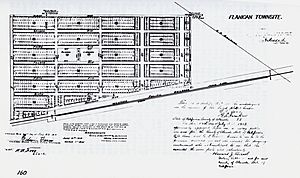Flanigan, Nevada facts for kids
Quick facts for kids
Flanigan, Nevada
|
|
|---|---|

View toward Flanigan townsite and the former Western Pacific line, 2015
|
|

Flanigan townsite surveyor map, 1913
|
|
| Country | United States |
| State | Nevada |
| County | Washoe |
| Established | 1909 |
| Deed filed | July 16, 1913 |
| Abandoned | 1973 |
| Elevation | 4,006 ft (1,221 m) |
| Time zone | UTC-8 (Pacific (PST)) |
| • Summer (DST) | UTC-7 (PDT) |
| ZIP codes |
89510
|
| Area code(s) | 775 |
| GNIS feature ID | 840501 |
Flanigan is a ghost town in Washoe County, Nevada. A ghost town is a place where people used to live and work, but now almost no one does. Flanigan is located in the Honey Lake Valley. It is about 5 miles (8 km) east of the California border. This area is a high desert region. It has mostly flat, dry land with some sagebrush plants.
Contents
The Story of Flanigan
How Flanigan Began
Flanigan started in 1909. This was when the Western Pacific Railroad built its tracks. These tracks connected Oakland to Salt Lake City. The train station in Honey Lake Valley was named after Patrick L. Flanigan. He was a local landowner and businessman. The railroad bought land from him.
In 1913, another railroad, the Southern Pacific Railroad, built a line. This new line crossed the Western Pacific tracks at Flanigan. A legal document for the Flanigan Townsite was officially filed on July 16, 1913.
Growth and Challenges
The town grew after the train station opened. A post office was set up in the spring of 1914. A schoolhouse was built that summer. By July, it even had its own voting area. Most of the town's growth came from the railroads. Many residents were employees of the Southern Pacific and Western Pacific lines.
Flanigan's population reached a few hundred people in the 1920s. People sometimes hoped to find oil, natural gas, or a material called bog lime there. However, these hopes never worked out. A big problem was that no good well water was ever found. Water had to be brought in by train.
Why Flanigan Became a Ghost Town
Over time, fewer and fewer people lived in Flanigan. By the 1950s, only a few residents remained. In March 1959, the Southern Pacific Railroad closed its station in Flanigan. By the fall of 1960, only one person lived there permanently. This was Gertrude Milne, a schoolteacher. She ran the town store and taught seven children from nearby areas.
The post office closed in March 1961. A fire destroyed the store in January 1969. The school closed in the spring of 1969. Gertrude Milne moved away in 1973, and Flanigan became a true ghost town.
Later Attempts and the End
In the 1970s, some investors bought land near Flanigan. They wanted to sell small plots of land. They hoped to make it a fun, old Western ghost town. They even thought about giving land to famous actors like John Wayne and Clint Eastwood. This would bring a lot of attention to the area.
However, a law required new developments to have basic things like sewers. This made the plan too expensive, so it was stopped. In 1985, a large wildfire swept through the area. It destroyed the last few buildings that were left in Flanigan.



